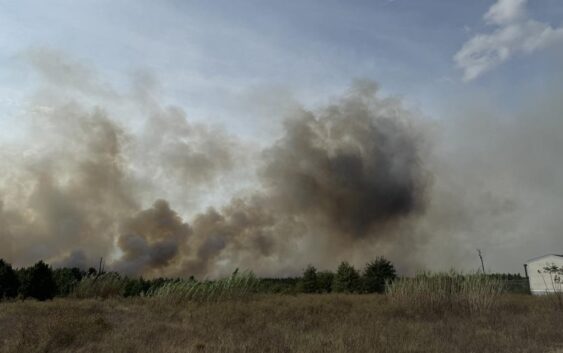- At least 4 dead, hundreds rescued after deadly floods ravage South Texas
- Today on Texas Standard: Deadly floods swamp South Texas, shatter records
- North Carolina radio station was a critical lifeline after Hurricane Helene. Then it became the voice of recovery.
- As storms approach, Rock Hill residents look back on last April's devastating hailstorm
- As storms approach, Rock Hill residents look back on last April's devastating hailstorm
Multiple homes evacuated as crews work to contain massive wildfire in Bastrop County

Around 40 to 50 homes were evacuated as the fire spread to 400 acres near Smithville.
AUSTIN, Texas — Many people were forced to evacuate their homes as crews work to contain a 400-acre wildfire that started in Bastrop County Sunday afternoon.
According to the Texas A&M Forest Service, the wildfire – named the Hudson Fire – began just after noon, eight miles east of Bastrop city limits, north of SH 71.
As of 6:30 p.m. Sunday, the fire has spread across 400 acres and is 10% contained.
Around 40 to 50 homes were evacuated after the Bastrop County Sheriff’s Office issued precautionary evacuation orders in the area between Alum Creek Road and Cottletown Road, as wind began blowing the fire northward. Subsequent evacuations were issued at 3 p.m. for residents from SH 71 at Alum Creek Road north to Gotier Trace.
Will Sellers is a neighbor who is renting a nearby property and is most concerned about his animals.
“So right now, I got three dogs and two goats. I have no idea if they’re safe,” Sellers said. “Pretty nervous definitely. Definitely more concerned about them than material stuff over there.”
Residents who were asked to evacuate can stay at the Smithville Recreation Center at 106 Royston St. Animals are not allowed at the shelter, but local agriculture and animal services are working on a plan for animals impacted by the fire.
Texas Parks and Wildlife, Bastrop County ESD 2, STAR Flight and the Smithville Fire Department are assisting the Texas A&M Forest Service as they attempt to contain the fire. Two STAR Flight helicopters and Forest Service “super scoopers” are being used to battle the fire.
The cause of the fire is still under investigation.
This area of Bastrop County is no stranger to wildfires. The Powder Keg Fire burned 117 acres in a similar area of the county in August 2023.
“We have plants that are a little bit more flammable with a little bit less rain to support that. And of course, we do have also the number one cause of fires in Texas in that area. and that’s people,” Kari Hines with Texas A&M Forest Service said.